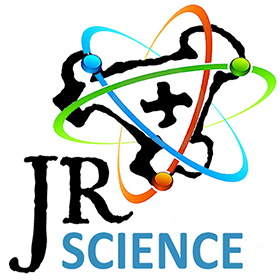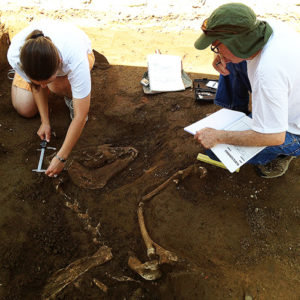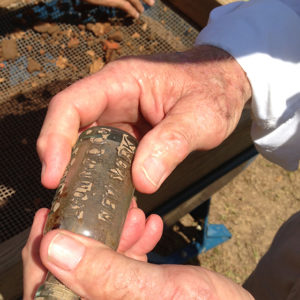 Excavations in the north churchyard of the 1907 Memorial Church have found an unusual burial near the human graves: a complete horse.
Excavations in the north churchyard of the 1907 Memorial Church have found an unusual burial near the human graves: a complete horse.
At the end of the June, the bones of the mature horse appeared in a ditch that dates to sometime after 1650. It’s not known how long the ditch was open, but this current area of excavation has a diverse mix of artifacts. It has been a graveyard and a section of James Fort inside a palisade extension. Plowing soil and reshaping landscape fill in the area has apparently blended together objects from three centuries of life on Jamestown Island.
“I’m surprised that we haven’t found a large fort-period feature yet because in the plowed soil above the ditch we are finding a lot of fort-period artifacts,” said Danny Schmidt, Senior Staff Archaeologist with the Jamestown Rediscovery Project.
The archaeologists moved carefully as they worked around the horse skeleton because exposing the brittle horse bones to too much air and sun could shatter them.
“It’s another great discovery. It happens all the time: We don’t know exactly what kind of horses were here, but now we have found something, and so we will hit the documents to see what we can find that we didn’t notice before,” said Dr. William M. Kelso, head of archaeological research at Historic Jamestowne.
“It’s great to find surprises like this and then search for a story you didn’t think about before.” The horse’s skull was uncovered June 24, and the next day the bones in the soil were examined by two zooarchaeologists: Stephen Atkins, associate curator of environmental archaeology at the Colonial Williamsburg Foundation, and Jenna Carlson, a graduate student at the College of William and Mary who is an intern at CW. They said the animal was likely a male and aged, but they could not fully rule out the possibility that this could have been a mule. Further analysis once the bones are removed from the ground would be required to scientifically confirm that it is a horse and not a mule.
The 2013 Field School students working with staff have also found three small glass bottles of “Mexican Mustang Liniment” made by the Lyon Manufacturing Company of New York between 1880 and 1907. The bottles came out of landscape fill placed in the area long after the ditch was used to bury the horse. While horse liniment, the Mustang salve was also used by people and may have been applied to the aching muscles of Jamestown’s first archaeologists—the ladies of the APVA, as they uncovered the foundations of the early churches by the brick tower.
Also notable among the artifacts found in June are a copper Irish penny dated 1601 and nine lead tokens bearing a crowned double rose and the legend “God Save the Qvene.”
Bly Straube, Senior Archaeological Curator for the Jamestown Rediscovery Project, said the Irish penny was part of an English debased coinage scheme in 1601 and 1602 to provide low denomination coins for paying English soldiers fighting in Ireland. The purpose of the lead Elizabethan tokens is unknown, but both the coin and the tokens are part of a group of more than 200 obsolete numismatic objects that have been recovered during the Jamestown Rediscovery excavations, she said. It is possible that these coins and tokens were meant to be used in the colony as an internal currency among the settlers, Straube said.
The exploration of several sections off the northeast corner of the Memorial Church has also confirmed that the partial brick walls that sit above ground are 20th century markers that mimic what existed earlier. They frame the centuries-old graves the same way markers on the ground in the New Town section of Jamestown Island outline buildings that existed in the 1600s.
The brick wall that runs underground through the sections being excavated is about six inches narrower than the brick wall above ground. Carl Lounsbury, senior architectural historian at the Colonial Williamsburg Foundation, also confirmed that the two walls have different mortar. The above-ground bricks are in an irregular “junk bond” setting bound with concrete mortar, which is modern. The below-ground wall has English bond with real mortar.
The earlier wall used bricks from the Jamestown church that started falling into ruin after being desanctified in the mid-1700s, Straube said. The wall was built in the late 1700s or early 1800s by William Ludwell Lee of Greenspring and John Ambler to enclose part of the churchyard that contained ancestral graves, she said.
related images
- Jenna Carlson, a graduate student at the College of William and Mary, measures part of the horse
- Mexican Mustang Liniment Bottle Found Near the Horse Skeleton







